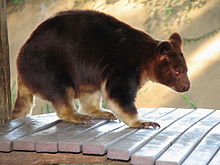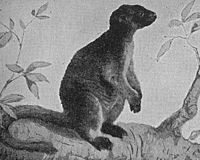- Tree-kangaroo
-
Tree-kangaroo[1] [ers' Tree-kangaroo]], Dendrolagus goodfellowi buergersi Scientific classification Kingdom: Animalia Phylum: Chordata Class: Mammalia Infraclass: Marsupialia Order: Diprotodontia Family: Macropodidae Subfamily: Macropodinae Genus: Dendrolagus
Müller, 1840Type species Dendrolagus ursinus
Müller, 1840Species about 12; see text.
Tree-kangaroos are macropods adapted for life in trees. They are found in the rainforests of New Guinea, far northeastern Queensland, and nearby islands. Although most are found in mountainous areas, several species also occur in lowlands, such as the aptly named Lowlands Tree-kangaroo. Most tree-kangaroos are considered threatened due to hunting and habitat loss.
There are 14 species of tree-kangaroos, though some uncertainty exists due to taxonomy. Depending on species, there are significant variations in the colour of the pelage and size, with a head and body length of 41 to 77 centimetres (16 to 30 in), a tail length of 40 to 87 centimetres (16 to 34 in), and a weight of up to 14.5 kilograms (32 lb). Females are smaller than males.
Contents
Evolution
It is understood that tree-kangaroos evolved from creatures similar to modern kangaroos and wallabies, as they retain many standard macropod adaptations to life in the plains—notably the massive hind legs and long, narrow feet which allow orthodox macropods to travel quickly and economically on the ground. Tree-kangaroos have developed exceptionally long tails for balance, and stronger forelimbs for climbing. The feet are shorter and wider, they have longer claws on all feet, and rubbery soles for better grip.
The ancestors of all kangaroos are believed to have been small arboreal marsupials that looked like some of Australia's present-day possums. The earliest macropods diverged from this line when they descended to the ground and evolved bodies adapted for rapid motion over the earth and rocks. Why the ancestors of the tree-kangaroos returned to the trees is not known, but it is believed to have happened due to a lack of open ground in their modern habitat. Thus, those who were able to live in trees were naturally selected to survive.
Locomotion
Tree-kangaroos are slow and clumsy on the ground. They move at about walking pace and hop awkwardly, leaning their body far forward to balance the heavy tail. But in trees they are bold and agile. They climb by wrapping the forelimbs around the back of a tree and hopping with the powerful hind legs, allowing the forelimbs to slide. They are expert leapers; 9 metres (30 ft) downward jumps from one tree to another have been recorded, and they have the extraordinary ability to jump to the ground from 18 metres (59 ft) or more without being hurt.
Diet
Tree-kangaroos feed mostly on leaves and fruit, taken both in trees and on the ground, but other foods are eaten when available, including grain, flowers, sap, bark, eggs and young birds. Their teeth are adapted for tearing leaves rather than cutting grass, and are not necessarily suited for anything other than an omnivorous diet. They have large stomachs that function as fermentation vats in a manner similar to those of eutherian ruminant herbivores, in which bacteria break down fibrous leaves and grasses. Although the arrangement of the stomach compartments in kangaroos is quite different than eutherian ruminants, the end result is similar.
Species
The following species are assigned to the genus Dendrolagus:[1]
- Grizzled Tree-kangaroo, Dendrolagus inustus; northern and western New Guinea, plus the island of Yapen, and possibly Salawati and Waigeo.
- Lumholtz's Tree-kangaroo, Dendrolagus lumholtzi; Queensland, Australia.
- Bennett's Tree-kangaroo, Dendrolagus bennettianus; Queensland, Australia.
- Ursine Tree-kangaroo, Dendrolagus ursinus; Vogelkop, New Guinea.
- Matschie's Tree-kangaroo, Dendrolagus matschiei; Huon Peninsula, New Guinea.
- Doria's Tree-kangaroo, Dendrolagus dorianus; western, central, and southeastern New Guinea.
- Seri's Tree-kangaroo, Dendrolagus stellarum; highlands of west-central New Guinea.
- Goodfellow's Tree-kangaroo, Dendrolagus goodfellowi; central and southeastern New Guinea.
- Golden-mantled Tree-kangaroo, Dendrolagus pulcherrimus; Foja and Torricelli Mountains, New Guinea.
- Lowlands Tree-kangaroo, Dendrolagus spadix; south-western lowlands of Papua New Guinea.
- Dingiso, Dendrolagus mbaiso; highlands of west-central New Guinea
- Tenkile, Dendrolagus scottae; Sandaun Province, New Guinea.
The taxonomy, especially of the Dendrolagus dorianus and Dendrolagus goodfellowi superspecies, is complex. The taxon stellarum was described as a subspecies of the D. dorianus,[2][3] but some recent authorities have treated it as a species based on its absolute diagnostability.[1] It has further been suggested that the taxon mayri, known only from a single old specimen, may represent a valid species,[4] but as it is virtually unknown, most authorities have retained it as a subspecies of D. dorianus.[1] The case for pulcherrimus is comparable to that of stellarum. It was initially described as a subspecies of Dendrolagus goodfellowi,[2] but recent authorities have elevated it to species status based on its absolute diagnostability.[1] A population of the Tenkile recently discovered from the Bewani Mountains may represent an undescribed subspecies.[5]
See also
References
- ^ a b c d e Groves, C. (2005). Wilson, D. E., & Reeder, D. M, eds. ed. Mammal Species of the World (3rd ed.). Baltimore: Johns Hopkins University Press. pp. 59-61. OCLC 62265494. ISBN 0-801-88221-4. http://www.bucknell.edu/msw3.
- ^ a b Flannery, T. 1995. Mammals of New Guinea. Reed Books. ISBN 0 7301 0411 7
- ^ Nowak, R. (ed) 1999. Walker's Mammals of the World. 6th edition. Johns Hopkins University Press. ISBN 0-8018-5789-9
- ^ Wondiwoi Tree Kangaroo Tenkile Conservation Alliance
- ^ Tenkile Tree Kangaroo Tenkile Conservation Alliance
- Flannery, Timothy Fridtjof, et al. 1996. Tree Kangaroos: A Curious Natural History. Reed Books, Melbourne. ISBN 0-7301-0492-3
External links
- Tree-kangaroo at the Encyclopedia of Life
- ARKive - images of the Goodfellow's tree kangaroo (Dendrolagus goodfellowi)
- Tree Kangaroo Conservation Program at Woodland Park Zoo - [1]
- National Geographic coverage of Tree kangaroos
Categories:- Macropods
- Mammals of Queensland
- Mammals of Papua New Guinea
- Mammals of Western New Guinea
Wikimedia Foundation. 2010.




